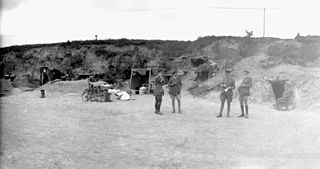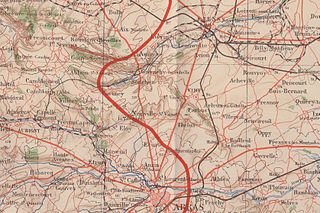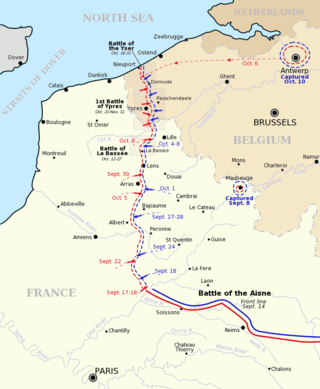
The Third Battle of Ypres, also known as the Battle of Passchendaele, was a campaign of the First World War, fought by the Allies against the German Empire. The battle took place on the Western Front, from July to November 1917, for control of the ridges south and east of the Belgian city of Ypres in West Flanders, as part of a strategy decided by the Allies at conferences in November 1916 and May 1917. Passchendaele lies on the last ridge east of Ypres, 5 mi (8 km) from Roulers, a junction of the Bruges-(Brugge)-to-Kortrijk railway. The station at Roulers was on the main supply route of the German 4th Army. Once Passchendaele Ridge had been captured, the Allied advance was to continue to a line from Thourout to Couckelaere (Koekelare).

The Battle of Vimy Ridge was part of the Battle of Arras, in the Pas-de-Calais department of France, during the First World War. The main combatants were the four divisions of the Canadian Corps in the First Army, against three divisions of the German 6th Army. The battle occurred from 9 to 12 April 1917, marking the commencement of the Battle of Arras and serving as the inaugural assault of the Nivelle Offensive. The objective was to draw German reserves away from the French forces, preparing for a crucial offensive along the Aisne and the Chemin des Dames ridge several days later.

General Sir Arthur William Currie, was a senior officer of the Canadian Army who fought during World War I. He had the unique distinction of starting his military career on the very bottom rung as a pre-war militia gunner before rising through the ranks to become the first Canadian commander of the Canadian Corps. Currie's success was based on his ability to rapidly adapt brigade tactics to the exigencies of trench warfare, using set piece operations and bite-and-hold tactics. He is generally considered to be among the most capable commanders of the Western Front, and one of the finest commanders in Canadian military history.

The Canadian Corps was a World War I corps formed from the Canadian Expeditionary Force in September 1915 after the arrival of the 2nd Canadian Division in France. The corps was expanded by the addition of the 3rd Canadian Division in December 1915 and the 4th Canadian Division in August 1916. The organization of a 5th Canadian Division began in February 1917 but it was still not fully formed when it was broken up in February 1918 and its men used to reinforce the other four divisions.

The 1st Canadian Division is a joint operational command and control formation based at CFB Kingston, and falls under Canadian Joint Operations Command. It is a high-readiness unit, able to move on very short notice, and is staffed and equipped to meet Canada’s military objectives to counter any potential threat.

The Canadian National Vimy Memorial is a war memorial site in France dedicated to the memory of Canadian Expeditionary Force members killed during the First World War. It also serves as the place of commemoration for Canadian soldiers of the First World War killed or presumed dead in France who have no known grave. The monument is the centrepiece of a 100-hectare (250-acre) preserved battlefield park that encompasses a portion of the ground over which the Canadian Corps made their assault during the initial Battle of Vimy Ridge offensive of the Battle of Arras.

The Battle of Arras was a British offensive on the Western Front during the First World War. From 9 April to 16 May 1917, British troops attacked German defences near the French city of Arras on the Western Front. The British achieved the longest advance since trench warfare had begun, surpassing the record set by the French Sixth Army on 1 July 1916. The British advance slowed in the next few days and the German defence recovered. The battle became a costly stalemate for both sides and by the end of the battle, the British Third Army and the First Army had suffered about 160,000 casualties and the German 6th Army about 125,000.

The Second Battle of Artois from 9 May to 18 June 1915, took place on the Western Front during the First World War. A German-held salient from Reims to Amiens had been formed in 1914 which menaced communications between Paris and the unoccupied parts of northern France. A reciprocal French advance eastwards in Artois could cut the rail lines supplying the German armies between Arras and Reims. French operations in Artois, Champagne and Alsace from November–December 1914, led General Joseph Joffre, Generalissimo and head of Grand Quartier Général (GQG), to continue the offensive in Champagne against the German southern rail supply route and to plan an offensive in Artois against the lines from Germany supplying the German armies in the north.

The Third Battle of Artois was fought by the French Tenth Army against the German 6th Army on the Western Front of the First World War. The battle included the Battle of Loos by the British First Army. The offensive, meant to complement the Second Battle of Champagne, was the last attempt that year by Joseph Joffre, the French commander-in-chief, to exploit an Allied numerical advantage over Germany. Simultaneous attacks were planned in Champagne-Ardenne to capture the railway at Attigny and in Artois to take the railway line through Douai, to force a German withdrawal from the Noyon salient.

Vimy Ridge Day is a day to commemorate the deaths and casualties of members of the Canadian Corps in the Battle of Vimy Ridge, which took place during the First World War. The holiday has been observed annually on 9 April since 2003. It is a non-statutory observance.

The Battle of Neuve Chapelle took place in the First World War in the Artois region of France. The attack was intended to cause a rupture in the German lines, which would then be exploited with a rush to the Aubers Ridge and possibly Lille. A French assault at Vimy Ridge on the Artois plateau was also planned to threaten the road, rail and canal junctions at La Bassée from the south as the British attacked from the north. The British attackers broke through German defences in a salient at the village of Neuve-Chapelle but the success could not be exploited.

The Battle of Albert began on 25 September 1914, in what became known as the "Race to the Sea", during the First World War. It followed the First Battle of the Aisne as both sides moved northwards, trying to turn the northern flank of their opponent. The Second Army, began to assemble at Amiens in mid-September and was directed by General Joseph Joffre, the Generalissimo of the French Army, to attack near Albert.

The military history of Canada during World War I began on August 4, 1914, when the United Kingdom entered the First World War (1914–1918) by declaring war on Germany. The British declaration of war automatically brought Canada into the war, because of Canada's legal status as a British Dominion which left foreign policy decisions in the hands of the British parliament. However, the Canadian government had the freedom to determine the country's level of involvement in the war. On August 4, 1914, the Governor General declared a war between Canada and Germany. The Militia was not mobilized and instead an independent Canadian Expeditionary Force was raised.

The Battle of Arras, was an attempt by the French Army to outflank the German Army, which was attempting to do the same thing during the "Race to the Sea", their reciprocal attempts to exploit conditions created during the First Battle of the Aisne. At the First Battle of Picardy (22–26 September) each side had attacked expecting to advance round an open northern flank and found instead that troops had arrived from further south and extended the flank northwards.
The 1st Bavarian Reserve Division was a unit of the Royal Bavarian Army, part of the German Army, in World War I. The division was formed on mobilization of the German Army in August 1914 as part of I Royal Bavarian Reserve Corps. The division was disbanded in 1919 during the demobilization of the German Army after World War I. The division was raised and recruited in Bavaria. As a reserve division, it included many recalled reservists and war volunteers.

In 1917, during the First World War, the armies on the Western Front continued to change their fighting methods, due to the consequences of increased firepower, more automatic weapons, decentralisation of authority and the integration of specialised branches, equipment and techniques into the traditional structures of infantry, artillery and cavalry. Tanks, railways, aircraft, lorries, chemicals, concrete and steel, photography, wireless and advances in medical science increased in importance in all of the armies, as did the influence of the material constraints of geography, climate, demography and economics. The armies encountered growing manpower shortages, caused by the need to replace the losses of 1916 and by the competing demands for labour by civilian industry and agriculture. Dwindling manpower was particularly marked in the French and German armies, which made considerable changes in their methods during the year, simultaneously to pursue military-strategic objectives and to limit casualties.

The Capture of Oppy Wood was an engagement on the Western Front during the First World War on 28 June 1917. The Battle of Arras of 1917 ended with the Germans in possession of a fortified wood to the west of the village of Oppy, which overlooked British positions. The wood was 1 acre (0.4 ha) in area and contained many German observation posts, machine-gun nests and trench mortars. New German defensive tactics adopted after the Battle of the Somme of defence in depth and rapid counter-attack, had been enforced on the German 6th Army after the disaster of 9 April, the first day of the Battle of Arras. The British attack of the Third Battle of the Scarpe (3–4 May), was defeated everywhere bar Fresnoy, which was captured by the 1st Canadian Division. The attack on Oppy Wood by the 92nd Brigade of the 31st Division, was a costly failure. The area was defended by the 1st Guard Reserve Division and the 15th Reserve Division, which did not need the support of specialist Eingreif (counter-attack) divisions.

The German attack on Vimy Ridge was a local German attack on Vimy Ridge. The attack took place on 21 May 1916 on the Western Front during the First World War. At the Third Battle of Artois the French Tenth Army captured positions on the western slope of Vimy Ridge and the German 6th Army was forced back to positions on the steeper eastern slope. Both sides resorted to a continuous underground offensive. The Tenth Army was transferred south in March 1916, during the Battle of Verdun and the British First Army and Third Army on either flank extended their lines to take over Vimy Ridge.

The German attack on Vimy Ridge was a local attack on the Western Front on 21 May 1916, during the First World War. The Germans intended to prevent mines being blown under German positions by capturing the British front line and mine gallery entrances. After the Third Battle of Artois the French Tenth Army had held positions on the western slope of Vimy Ridge and the German 6th Army occupied positions on the steeper eastern slope. During the Battle of Verdun, the Tenth Army was withdrawn and the British First Army and Third Army, on either flank, took over the French positions.

















